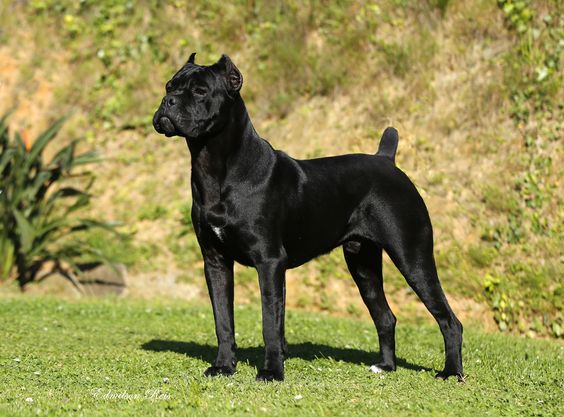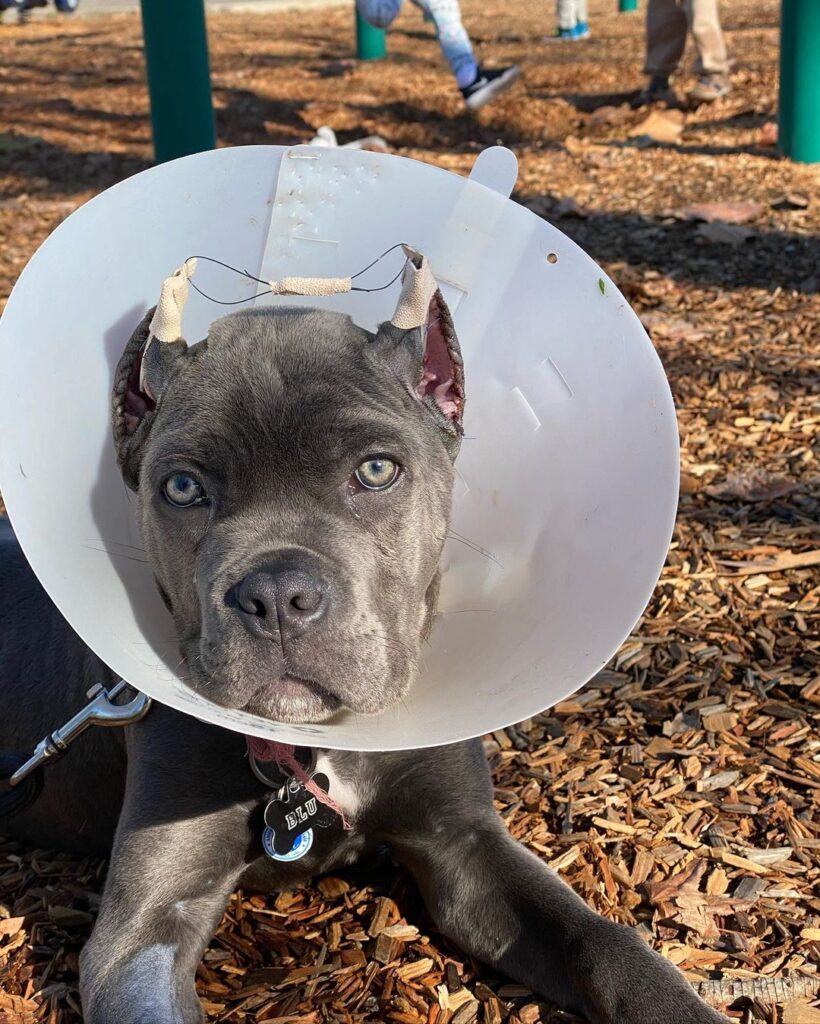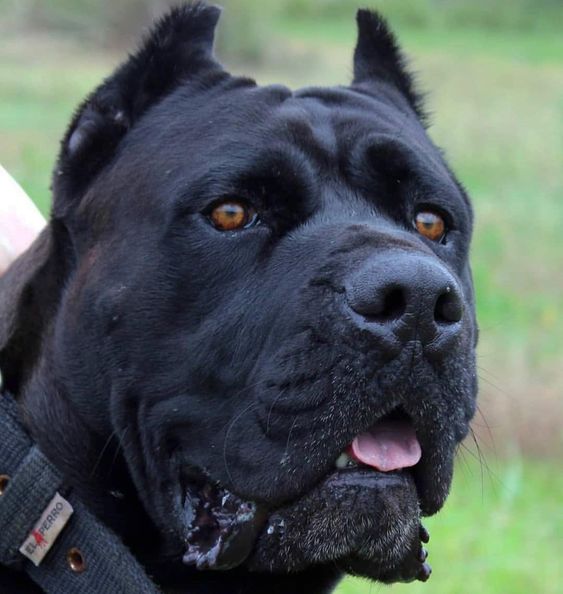
The decision to dock a Cane Corso’s tail is a topic that often sparks passionate debates among dog owners and enthusiasts. Tail docking involves the surgical removal of a portion of the tail, typically when the puppy is only a few days old. This practice has historical roots, with some claiming that it was originally done to prevent injuries in working dogs. However, in today’s world, the choice to dock a Cane Corso’s tail is not as clear-cut. “Cane Corso Docked Tail”
Tail docking is a matter of personal preference, aesthetics, and adherence to breed standards. Some owners opt for tail docking to maintain the traditional look of the breed, as it is a common practice in Cane Corso history. Others choose to keep their Cane Corsos’ tails intact, valuing the natural appearance of a long tail. The decision often hinges on a combination of aesthetics and concern for the dog’s well-being.
Cane Corso Docked Tail vs. Long Tail
When it comes to Cane Corso tail lengths, there are significant differences in appearance and function. The choice between a docked tail and a long tail is primarily a matter of aesthetics and personal preference.
Pros and Cons of Docking Your Cane Corso’s Tail
Pros:
- Reduced risk of tail injuries: Docking can prevent tail injuries, especially in active Cane Corsos who might injure their tails while playing.
- Breed standards: In some dog shows and competitions, docked tails are preferred to adhere to breed standards.
Cons:
- Ethical concerns: Many animal welfare organizations oppose tail docking, citing ethical reasons and potential pain to the puppy.
- Loss of communication: Dogs use their tails to communicate, and docking can limit their ability to express themselves to other dogs and humans.
The Natural Beauty of a Long Cane Corso Tail
A long, undocked tail showcases the Cane Corso’s natural elegance. It provides a clear means of non-verbal communication, with tail wagging indicating joy and excitement. Moreover, an undocked tail doesn’t interfere with the dog’s ability to express itself physically, allowing for more nuanced interactions with other dogs.
Should You Dock Your Cane Corso’s Tail?
The question of whether to dock your Cane Corso’s tail is a pivotal one, and it requires careful consideration. Tail docking is a surgical procedure that involves the removal of a portion of the tail. While it has historical roots, its modern-day application raises ethical and practical concerns.
The Ethics of Tail Docking
Before deciding to dock your Cane Corso’s tail, it’s essential to understand the ethical implications of this practice. Many animal welfare organizations and veterinarians oppose tail docking for several reasons. One primary concern is the potential pain and distress it can cause to the puppy, as it is often done without anesthesia or proper pain management in young dogs. Additionally, tail docking can be seen as a cosmetic procedure that serves no medical purpose, leading to questions about its necessity.
Ethical concerns also extend to the principle of autonomy. Shouldn’t a dog have the autonomy to express itself through its natural tail? Docking may limit a Cane Corso’s ability to communicate with other dogs and humans effectively. The tail is a vital part of a dog’s body language, and removing it can hinder their ability to convey emotions and intentions.
Tail Docking Procedure and Aftercare
Understanding the tail docking procedure and its aftercare is crucial if you are considering this option for your Cane Corso. The procedure typically takes place when the puppy is only a few days old. During the surgery, a portion of the tail is amputated. It’s essential to have this procedure performed by a qualified veterinarian who can ensure the puppy’s safety and comfort.
After the surgery, diligent aftercare is essential. The incision site must be kept clean and monitored for any signs of infection or complications. The puppy may experience discomfort during the healing process, so pain management and appropriate care are critical. It’s also essential to follow your veterinarian’s recommendations regarding rest and activity levels during the recovery period.
Does Docking Your Cane Corso’s Tail Affect Their Life?
Tail docking in Cane Corsos raises critical questions about how this practice can impact their lives. While some argue that tail docking is a preventive measure to reduce potential tail injuries, it’s essential to consider the broader effects on the dog’s well-being.
Health and Behavioral Implications
One of the primary concerns regarding tail docking is its potential impact on a Cane Corso’s health and behavior. When a portion of the tail is removed, the dog loses a crucial means of communication. Tails play a vital role in a dog’s social interactions, and by docking their tails, we limit their ability to express emotions effectively. This can lead to misunderstandings during dog-to-dog and dog-to-human interactions.
Moreover, the surgical procedure itself can be traumatic for the puppy. The removal of the tail without proper anesthesia or pain management can cause pain and distress. In some cases, complications such as infections can arise during the healing process. Behavioral changes during this period are not uncommon, as the dog may struggle with discomfort and the altered balance caused by the missing tail.
Long-Term Consequences
The long-term consequences of tail docking in Cane Corsos are a matter of ongoing debate. While proponents argue that docking can reduce the risk of tail injuries, opponents emphasize the importance of preserving the dog’s natural communication and physical expression.
There is limited scientific research on the long-term effects of tail docking, which makes it challenging to draw definitive conclusions. Some anecdotal evidence suggests that dogs with docked tails may be more prone to certain health issues, such as balance problems and altered gait patterns. Additionally, the psychological impact of having a portion of their tail removed could affect a Cane Corso’s overall temperament and well-being.
Where You Dock Your Cane Corso’s Tail
When it comes to tail docking for your Cane Corso, one crucial consideration is where the procedure should be done. The location on the tail where the docking is performed can impact not only the aesthetics but also the dog’s comfort and well-being.
The most common approach is a partial tail docking, typically removing about one-third to half of the tail’s length. This practice aims to strike a balance between preserving the dog’s natural communication abilities through the tail while reducing the risk of tail injuries. The exact placement of the docking is a matter of personal preference, but it’s essential to consult with a qualified veterinarian to ensure the procedure is performed correctly.
Legal Regulations
The legality of tail docking for Cane Corsos and other dog breeds varies widely depending on your location. In some countries and regions, tail docking is strictly regulated or even prohibited unless it’s for specific medical reasons. Legal restrictions often dictate how much of the tail can be removed and the age at which the procedure can be performed.
Before deciding to dock your Cane Corso’s tail, it’s crucial to research the laws and regulations in your area. Violating these regulations can result in penalties, and it’s essential to ensure that you’re in compliance with local animal welfare laws. Keep in mind that regulations can change, so it’s wise to stay informed about any updates or amendments to the rules in your region.
Choosing a Qualified Veterinarian

Selecting a qualified veterinarian to perform the tail docking procedure is paramount. A skilled and experienced veterinarian will not only ensure the procedure is done safely but also prioritize the puppy’s comfort and well-being throughout the process.
When choosing a veterinarian, consider their expertise in performing tail docking specifically for Cane Corsos. Ask for recommendations from fellow Cane Corso owners or breeders, and don’t hesitate to inquire about their experience and success with previous procedures. A compassionate and knowledgeable vet will also provide guidance on aftercare, pain management, and any potential complications that may arise during the healing process.
FAQs
Is tail docking necessary for Cane Corsos?
Tail docking is not medically necessary for Cane Corsos, but some owners opt for it for various reasons.
What are the potential benefits of tail docking?
Benefits may include reduced risk of tail injuries and adherence to breed standards.
Are there any health risks associated with tail docking?
There can be complications during or after the procedure, such as infection or improper healing.
Do long-tailed Cane Corsos have communication advantages?
Long-tailed Corsos may have enhanced non-verbal communication abilities.
Can I dock my Cane Corso’s tail at home?
No, tail docking should always be performed by a qualified veterinarian.
What is the ideal age for tail docking in Cane Corsos?
Tail docking is typically done when the puppy is a few days old.
Does tail docking affect a Cane Corso’s personality?
It shouldn’t drastically alter their personality, but some behavioral changes are possible during the healing process.
What should I expect during the tail docking healing process?
You should watch for signs of infection, and follow your vet’s aftercare instructions carefully.
Are there countries where tail docking is illegal for Cane Corsos?
Yes, tail docking is illegal or restricted in many countries.
Can I show a Cane Corso with an undocked tail in dog competitions?
Some dog shows accept long-tailed Cane Corsos, while others adhere to breed standards that prefer docked tails.
Conclusion
In conclusion, the choice to dock a Cane Corso’s tail is a multifaceted decision that encompasses ethical, legal, and practical considerations. This practice, deeply rooted in history, has evolved into a subject of passionate debate within the canine community. Each aspect discussed in this article plays a crucial role in helping responsible Cane Corso owners make an informed decision regarding their pet’s tail.
First and foremost, the ethics of tail docking weigh heavily on this decision. It’s essential to consider the potential pain and distress the procedure can cause to the puppy, as well as the impact on their ability to communicate effectively through their tail. Ethical concerns should guide us in making choices that prioritize the well-being and happiness of our canine companions.
With over 4 years of devoted companionship with my beloved Labrador Retriever, Robin, I have cultivated a deep understanding and expertise in all things canine. From training and behavior to health and well-being.


